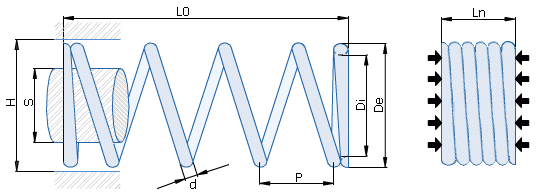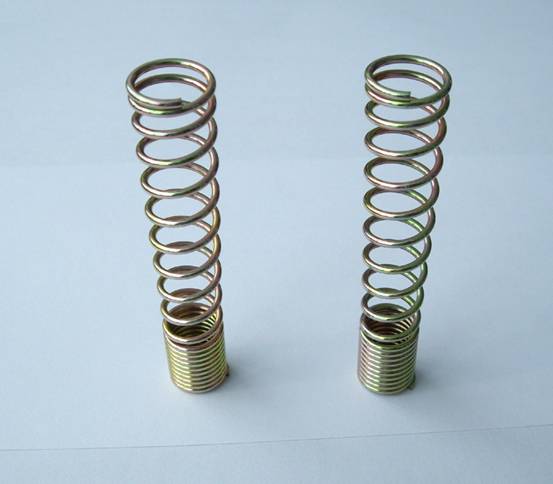Compression spring
1. wire diameter as below:
0.1mm – 3.0mm wire
3.1mm – 12mm wire
12.1mm – 65mm wire
2. ISO9001:2000 certified
3. Competitive price and fast delivery
4. These springs are manufactured by fully automatic spring making machine,low cost
Description of parameters for Compression spring

Compression Spring Physical parameters
d (wire diameter): This parameter describes the diameter of wire used as material for spring.
S (shaft): This parameter describes the maximum diameter of spring shaft in industrial applications. Tolerance for this parameter is (+-)2%(indicative).
Di (internal diameter): Internal diameter of a spring can be calculated by subtracting the doubled wire diameter from the external diameter of a spring. Tolerance for this parameter is (+-)2%(indicative).
De (external diameter): External diameter of a spring can be calculated by adding the doubled wire diameter to the internal diameter of a spring. Tolerance for this parameter is (+-)2%(indicative).
H (hole): This is the minimum diameter of the hole in which spring can work. Tolerance for this parameter is (+-)2%(indicative).
P (pitch): Average distance between two subsequent active coils of a spring. Tolerance for this parameter is (+-)2%(indicative).
Ln (block length): Maximal length of a spring after total blocking. This parameter is shown in the picture on right. Tolerance for this parameter is (+-)15%(indicative).
L0 (free length): Free length of compression springs is measured in its uncompressed state after previous one time blocking. Tolerance for this parameter is (+-)2%(indicative).
Nr of coils: This is a total number of coils in a spring - in the picture above it is equal to six. To calculate number of active coils substract two terminating coils from total number of coils.
R (spring rate): This parameter determines spring's resistance, while it is working. It is measured in 1 DaN/mm = 10 N/mm. Tolerance for this parameter is (+-)15%(indicative).
L1 & F1 (length at force F): Force F1 at length L1 can be calculated from equation : F1 = (L0-L1) * R. Equation derrived from previous for calculating L1 : L1 = L0 - F1/R.
Grinding: Defines whether or not the ends of a spring are ground.
Compression Spring Materials
A (Music Wire): Steel that conforms to the DIN 172233 class C1 standard.
I (Inox steel): Inox 18/8 mark Z10 CN 18.09.
N (Zn coated wire): Zinc coated wire for springs
S (Cr-Si Steel): Cr-Si Steel. Springs created from this material have better endurance and spring rate. These parts will be available from 2005-03-01
Compression Spring Tolerances
Ends: All compression springs have flat ends.
Spring rate: Tolerance for spring rate is (+-)15%(indicative).
Address: Defenghang Industrial Zone, Dongfu Town, Haicang District , Xiamen Fujian, P.R.China
Tel: +86(592)5254186 +86(592)5289710 Fax: +86(592)5513310
Email: shuangyuan@springinchina.com rosecn888@gmail.com







